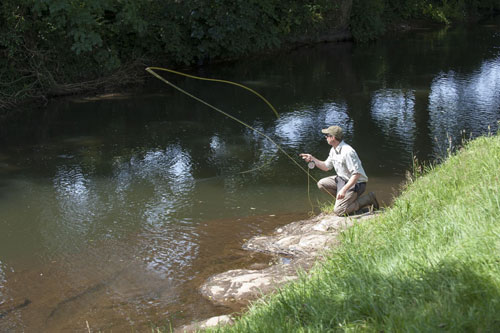The roll cast is important to learn and practice. Knowing several uses will make you a better fly angler. Here are a few thoughts on when and how to use it.
Something as simple as walking up to the water with fly in hand and no line extended out of the rod tip can be an issue. A flip of the line in the water, wiggle of the rod tip side to side, and a few roll casts can get several feet of line out. You may use a roll cast to make a forward cast in an area with little room for a back cast. You can use it to lift a sunken fly before starting your back cast. It also allows for slipping a little more line into your system and a false cast before starting the casting sequence. It’s also a great way to release a snagged fly. Make sure you cast the loop past the fly, let the line sit on the water and then snatch it back so the line tension pulls from the opposite direction of the eye of the hook.
All of those techniques make use of the water tension to load (bend) the rod. That water tension is a curse or a gift to a fly caster. Like the wind when casting, learn to use it to your advantage.
A roll cast is just a forward cast with a different back cast. The more line you can get behind you in the form of a ‘D’ or ‘V’ loop, the easier it is to make the forward cast. Moving fast in the back cast portion of the roll cast is rarely a benefit. Starting with the rod tip low, bring it up and slightly outside your shoulder with a constant rate of acceleration until you stop. Slow down and focus more on the placement of the line in the water column and proximity of the fly in relation to your position. The fly should be about a rod length in front of you and only a few feet off to the side of your casting shoulder. Get as much line behind you as you can.
Then, make a normal forward cast.
Try to make the line go out and over the target, not around as a ‘roll’ cast would imply. Since the forward cast is the same, don’t forget you can add a haul to accelerate the line if you would like. The same principal applies to false casts as a roll cast; short cast- short stroke, long cast-long stroke. One of the nice things about a roll cast is that the ‘timing’ variable is less important on the back cast. You can pull the line into position and form the ‘D’ loop and stop (unless you have a heavy fly) and then look back and see if you could reach your arm/hand back further without getting in the trees to aid on a longer cast.
There is one sidebar on this last comment, and you can test it by standing several feet from a wall with your back to it. If you bring your rod tip back a foot from the wall, stop and start the forward cast, your rod tip will hit the wall. Even if you did not go backward with your hand or rotate the rod back, there is a movement of your rod tip backward as your hand goes forward. I bring this up, because on the stream, if you bring your rod tip back as close to the trees before starting your forward cast, you will get hung up.
Try it out, practice the different type roll casts, (forward cast with a different back cast) and enjoy your time on the water.
